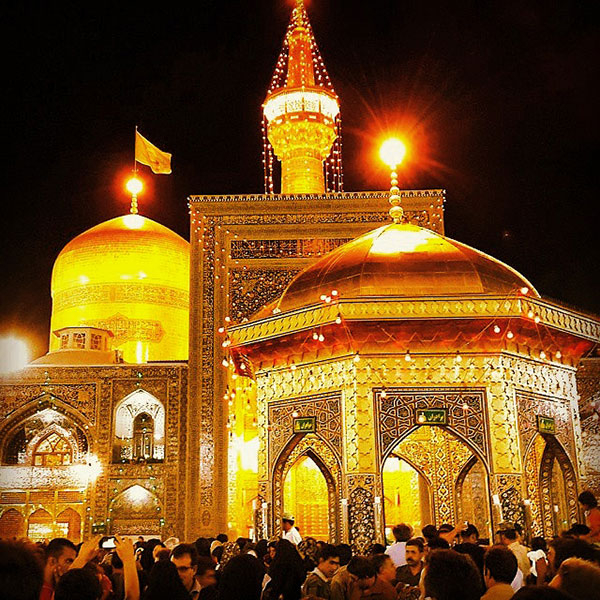The Zaydiyyah
Zayd ibn Ali ibn al-Husayn ibn Ali ibn Abi Talib, by the kunyah of Abu al-Hasan, was born in the year 75 AH from a bonds woman that Mukhtar had gifted to Imam Sajjad. He studied in the school of his father Imam Sajjad and brother, Imam Baqir. He was a scholar and devout, revolutionary, and intolerant of oppression. Imam Rida (AS) has counted him as a scholar of the household of the prophet. Because of his great acquaintance with the Quran, he was known as Halif al-Quran. He uprose during the reign of Hisham ibn Abd al-Malik in Kufah and attained the rank of martyrdom in Dhi al-Hijjah, 122 AH at the age of 42. His body was hung from four years until Yusuf ibn Umar burnt it in 126 AH. Zayd’s movement was continued by his son Yahya and his followers, and this movement expanded in Kufah, Iraq and then in Iran and Yemen. His companions, followers and all of those who believe in his imamate are called the Zaydiyyah.
‘Zaydiyyah’ literally denotes any group associated with Zayd ibn Ali ibn Husayn ibn Ali ibn Abi Talib (AS). (Abdul-Rahman ibn Muhammad ibn Khaldun, Diwaan al-Mubtada’ wal-Khabar fi Taarikh al-Arab wal-Barbar wa Man Aasarahum min Dhawi al-Sha’n al-Akbar, researched by Khalil Shahadah, Beirut: Daar al-Fikr, second edition, 1408 AH/1998 AND (vol. 1, p. 248). In his Ansaab, Sam’aani has described the Zaydiyyah like this: “Zaydi” is a term associated with Zayd ibn Ali ibn al-Husayn ibn Ali (AS) and the Zaydiyyah group are those linked to him either through lineage or faith”. (Abdul-Karim ibn Muhammad ibn Mansur al-Tamimi al-Sam’aani, Al-Ansaab, researched by Abdul-Rahman ibn Yahya al-Mu’allimi al-Yamaani (Haydar Abaad: The Ottoman Encyclopedia Assembly, first edition, 1382 AH/ 1962 AND) vol. 6, p. 365). Therefore, in denominational terminology, “Zaydiyyah” denotes a branch of Shi’ism whose adherents believed in the imamate of Zayd ibn Ali ibn Husayn (AS). (Abu al-Hasan Ali ibn al-Husayn ibn Ali al-Mas’udi, Muruj al-Dhahab wa Ma’aadin al-Jawhar (researched by As’and Daaghir, Qum, Daar al-Hijrah 1409 AH) second edition, p. 208; Abi Mansur Abd al-Qaahir ibn Taahir Baghdadi, Al-Farq bayn al-Firaz wa Bayan al-Firqat al-Naajiyah Minhum) Beirut: Daar al-Aafaaq al-Jadidah, third edition, 1978 AD, p. 25. Nobakhti describes the Zaydiyyah like this:
After Imam Husayn (AS), some believed that imamate solely belongs to the children of Hasan and Husayn and doesn’t apply to the other children of Ali (AS). They are all equal in imamate; any one of them who rises and calls the people to himself is an imam and obeying him is mandatory. When Zayd uprose in Kufah, this group joined him and chose him as their imam, hence, them taking on the name “Zaydiyyah”. (Abi Muhammad Hasan ibn Musa Nobakhti, Firaq al-Shi’ah, (Istanbul, 1931 AD, pp. 48-49).
The Zaydiyyah are also sometimes referred to as the Husayniyyah. They believe that whosoever from the family of the prophet calls the people to God and publicizes his cause, is an imam that must be obeyed and whoever disobeys him and doesn’t aid him in his movement and calls the people to himself instead, is a kafir. (Firaq al-Shi’ah, p. 58). The leaders of the Zaydiyyah, using different words and emphasizing that their association with Zayd is due to their creedal views and not jurisprudential ones, verify these definitions of “Zaydiyyah”.
In general, there is much controversy surrounding Zayd ibn Ali, such as the difference of opinion regarding the reasons for his rise, his birth and martyrdom dates, his personality, his jurisprudential and theological views, and his influence from Waasil ibn Agaa’ (head of the Mu’tazilites) and Abu Hanifah (founder of the Hanafi school). There is difference in most of the of the incidents that took place during the Umayyids and the origin of such, is due to the many and sometimes conflicting narrations in source and also due to the association of historians with the ruling entities of their time. This has led to ensuing authors and historians rejecting and justifying these narrations to be able to prove their own stances. (To learn of these differences, see: Tabari, vol. 7, pp 160-180).
Although his birth date hasn’t been clearly stated, yet according to the best and most accurate view recorded in history records, such as Maqaatil al-Talibiyyin, Tabaqaat Kubraa and Tabaqaat Ibn Sa’d, when Zayd was martyred, he was forty two years old and according to records such as Tabari, t was the year 122 AH in Kufah, it can be concluded that his birth was around the year 80 AH in Madinah. He had three wives and three umm walads. He had four children from his wives by the names of: Yahya ibn Zayd, who was killed in Khorasan in the year 125 AH, and was the next after Zayd for the Zaydiyyah, Isa ibn Zayd, Husayn ibn Zayd and Muhammad ibn Zayd. He had no daughters. (To further information, refer to Husayn Kariman, Sireh va Qiyame Zayd ibn Ali, pp 9-15).
The different branches of the Zaydiyyah school of thought: Most of these branches formed based on the views regarding imamate and leadership of society, dividing the Zaydiyyah into three major branches:
1. Jarudiyyah (Sarhubiyyah): A denomination of the Zaydiyyah associated with Abu al-Jarud Ziyad ibn Mundhir. This group believed that through his description of the imam after him, the prophet appointed Ali (AS) as his successor without making explicit mention of his name. they also believed that since the Sahabah didn’t pledge their allegiance to Ali (AS) they became kafirs, and this is why they would slander the first and second caliphs and would say that the two of them were kafirs and misguided.
2. Salihiyyah (Batriyyah): Followers of two individuals: Hasan ibn Salih ibn Hayy and Kathir al-Niwaa’, also known as al-Abtar. This branch of the Jarudiyyah were less misguided and were closer to Zayd in their beliefs and believed that although after the prophet, caliphate and imamate was the right of Ali ibn Abi Talib, and he was more deserving and qualified for this position, but since his excellence himself pulled aside from it, the caliphate of the first three caliphs was legitimate.
3. Sulaymaniyyah (Jaririyyah): This group’s belief revolved around the ideas and thought of Sulayman ibn Jarir Riqqi. They too, like the rest of the Shia, believed that imamate was the right of Ali (AS) and held that imamate must be decided on through a council of at least two high ranking figures of the Islamic nation. (For further information, see: Sa’d ibn Abdillah Ash’ari al-Qummi, Al-Maqalaat wa al-Firaq, p. 158; Shahrestani, Al-Milal wa al-Nihal, vol. 1, p. 225; Baghdadi, Al-Farq bayn al-Firaq wa Bayan al-Firqat al-Naajiyah Minhum, pp. 23-28; Sam’aani, Al-Ansaab, vol. 2, p. 78.)
Zaydi Governments
1. The Idrisids
Idris ibn Abdillah ibn Hasan ibn Hasan ibn Hasan ibn Al ibn Abi Talib (AS), one of the companions of the Martyr of Fakh who fled after his martyrdom to Egypt and from there, went to Andulus. Due to his association with the household of the prophet and his slogan of spreading the word of Islam, he was able to unify the tribal society of the West and establish an independent and unprecedented Alawid government in the year 172 AH in that region, which remained for two centuries until the year 317 AH, when it was wiped out by the Marwanids. (Taarikh Ibn Khaldun, ibid, vol. 4, pp 10-24).
2. The Alawites of Tabarestan
After the rise of the Zaydis in the central regions of the Muslim world and their suppression, many of the Zaydis and Sayyids migrated to different places. Due to the special geographical circumstances of Northern Iran, the grounds for inviting the people and drawing their support were available, thus, a group of the Sayyids such as Yahya ibn Abdullah ibn Hasan III, the brother of the founder of the Idrisids took to the cities of the Daylam and Gilan. (Baladhuri, vol. 3, p. 136).
In the year 250 AH, Hasan ibn Zayd ibn Muhammad ibn Ismail ibn Hasan ibn Zayd ibn Hasan ibn Ali ibn Abi Talib, who was known as ‘Al-Daa’i al-Kabir’, uprose during the rule of Al-Musta’in Billah against the Abbasids. The opposition of the people of Chalus and Tabarestan against Jaabir ibn Harun Nasraani, the delegate of the Abbasid ruler, caused Hasan ibn Zayd to move from his residence in Ray to Tabarestan. Upon his arrival, the inhabitants of Tabarestan and Daylam pledged their allegiance to him and he was able to defeat Sulayman ibn Abdullah in Amul. He was able to also take away the distance between Ray and close to Hamedan from the Taaheris. (Tabari, vol. 9, pp. 271-277; Ibn Athir, vol. 7, pp. 130-134; Tajaarub al-Umam, vol. 4, pp 330-334.)
After this period, until the imamate of Daa’i Saghir, other Zaydi imams became caliphs, but after the killing of Daa’i Saghir, with the exception of short periods, the Zaydis of Northern Iran did not succeed in establishing a unified government. Due to the attack of the Mongols and domestic issues such as the presence of the Ismailites, despite the emergence of other imams among the Zaydis of Tabarestan, with the dominance of the Safawids, the Zaydiyyah religion slowly ceased to exist in Iran and twelver Shias took over these regions.
3. The Zaydiyyah of Yemen
Thirty years after the establishment of the second Zaydi government in the year 284 AH, Yahya ibn Husayn ibn Qasim Rasiyy, known as al-Hadi ilal-Haqq al-Mubin established the Zaydi government of Yemen. None of the Zaydi imams have been seen as comparable to al-Hadi from a scholarly perspective. His scholarly status was cultivated next to his father and uncles in Madinah and wrote his first book at the age of seventeen and reached the level of ijtihad. Because of this, he is known to be the second most important figure of the Zaydiyyah after Zayd ibn Ali himself.
After Al-Hadi ilal-Haqq and the unfolding of events in the Arabian Peninsula and the Islamic world, the Zaydi imams were able to maintain the responsibility of guiding the Zaydis of Yemen in different periods and were also able to establish the most important base for Zaydis which still stands today. The different periods of the Zaydiyyah can be summarized into three general periods, namely:
1. The establishment of a government until their defeat by the Ismailites. (284-444 AH).
2. The revival of the Zaydiyyah. (532-965 AH).
3. Resistance against the Ottomans until the establishment of a republic in Yemen. (965-1382 AH).
(Al-Masabih, p. 581; Durar al-Ahaadith al-Nabawiyyah bil-Asanid al-Yahyawiyyah, p. 151; Al-Hayat al-Siyasiyyah wa al-Fikriyyah lil-Zaydiyyah fi al-Mashriq al-Islaamiyy, pp. 183 and on.)

















